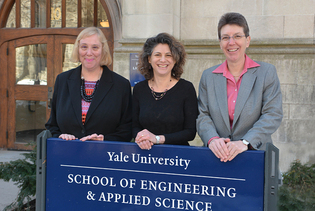 loading
loading
Light & VerityComputer science expands, moves to EngineeeringIn a tech-driven world, students wanted more courses and faculty.  Michael MarslandComputer science department chair Joan Feigenbaum (left), arts and sciences dean Tamar Gendler ’87 (center), and engineering dean Kyle Vanderlick celebrate the computer science department's move to the School of Engineering and Applied Sciences. View full imagePlaying catch-up in a tech-driven world, Yale will expand the computer science department and merge it into the School of Engineering and Applied Sciences. The “marriage,” announced March 26 with “byte-size” pieces of “wedding cake,” will soon produce a growing family: several new faculty positions, funded by a pair of anonymous donations, will bring the department’s strength to 26. That’s a historic high, according to department chair Joan Feigenbaum—but it’s still a “modest” size, officials acknowledge. Harvard plans a 50 percent increase, from 24 faculty to 36; Princeton is in the same ballpark. “I view this as the initial phase in a longer-term plan to enhance and expand the department,” President Peter Salovey ’86PhD says in an interview. (See “Computer Science Gets An Upgrade.”) Computer science currently has 19 faculty slots occupied by 20 professors (two are joint appointments), Feigenbaum says by e-mail. That’s the same as in 2004, and smaller than in 1986. Enrollment in computer science courses jumped from about 1,400 in 2004 to over 2,000 this year, she adds. The two donations, totaling $20 million, will fund three new junior faculty positions. Feigenbaum says that two new senior professors will hold joint appointments in computer science and elsewhere in the engineering school. “We were all overjoyed,” says Alex Reinking ’16, who was part of a recent student lobbying effort for more funding. “These new spots are going to take a load off the department.” The department has “one or two excellent people” in “quite a few areas,” Feigenbaum notes. But “one or two people is not enough to be considered ‘strong’ in twenty-first-century academic computer science.” Some other areas currently have no coverage at all, including applied machine learning, which Feigenbaum says is a priority because of great student interest. Ed Lazowska, a senior professor in the University of Washington’s highly ranked computer science department, calls Yale’s investment “heartening.” “Honestly, though, I am concerned by the move to the School of Engineering and Applied Sciences,” he says by e-mail: he believes Yale “at its heart” is a great university in the arts and sciences, with engineering “at the margin.” (In the 1990s, Yale briefly considered dissolving engineering altogether. In 2008 it increased the number of faculty in SEAS, but with 80 faculty on the professorial track today, the school is smaller than, for instance, Stanford’s 241, or Princeton’s 145 permanent faculty.) Feigenbaum, however, sees “no inherent reason for engineering to be ‘marginal’ at Yale. Members of the Yale community who understand the central role of computing in the most important intellectual, cultural, economic, and political developments of our time will expect Yale to have a world-class computer science department, regardless of whether that department is in SEAS.”
The comment period has expired.
|
|